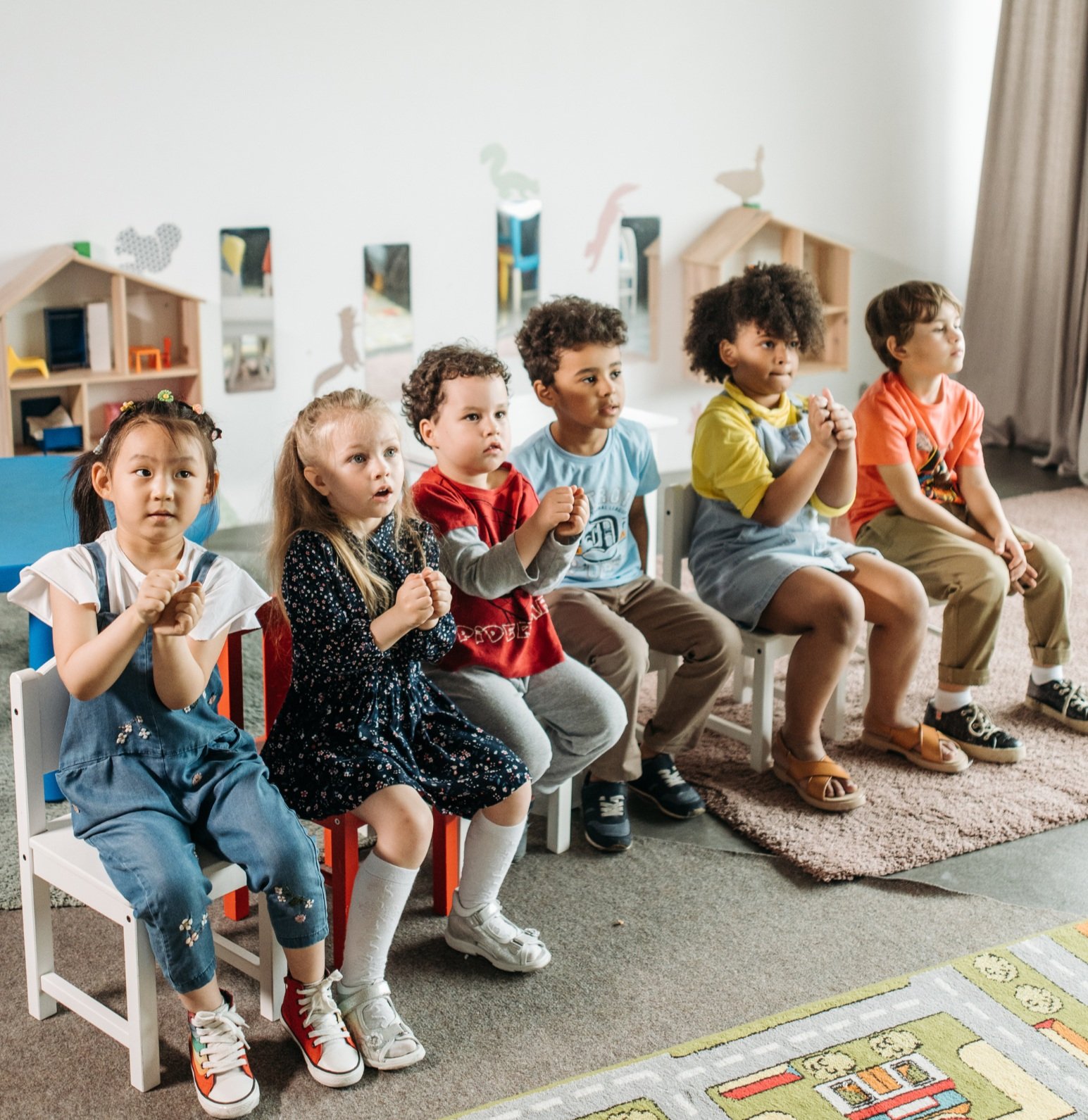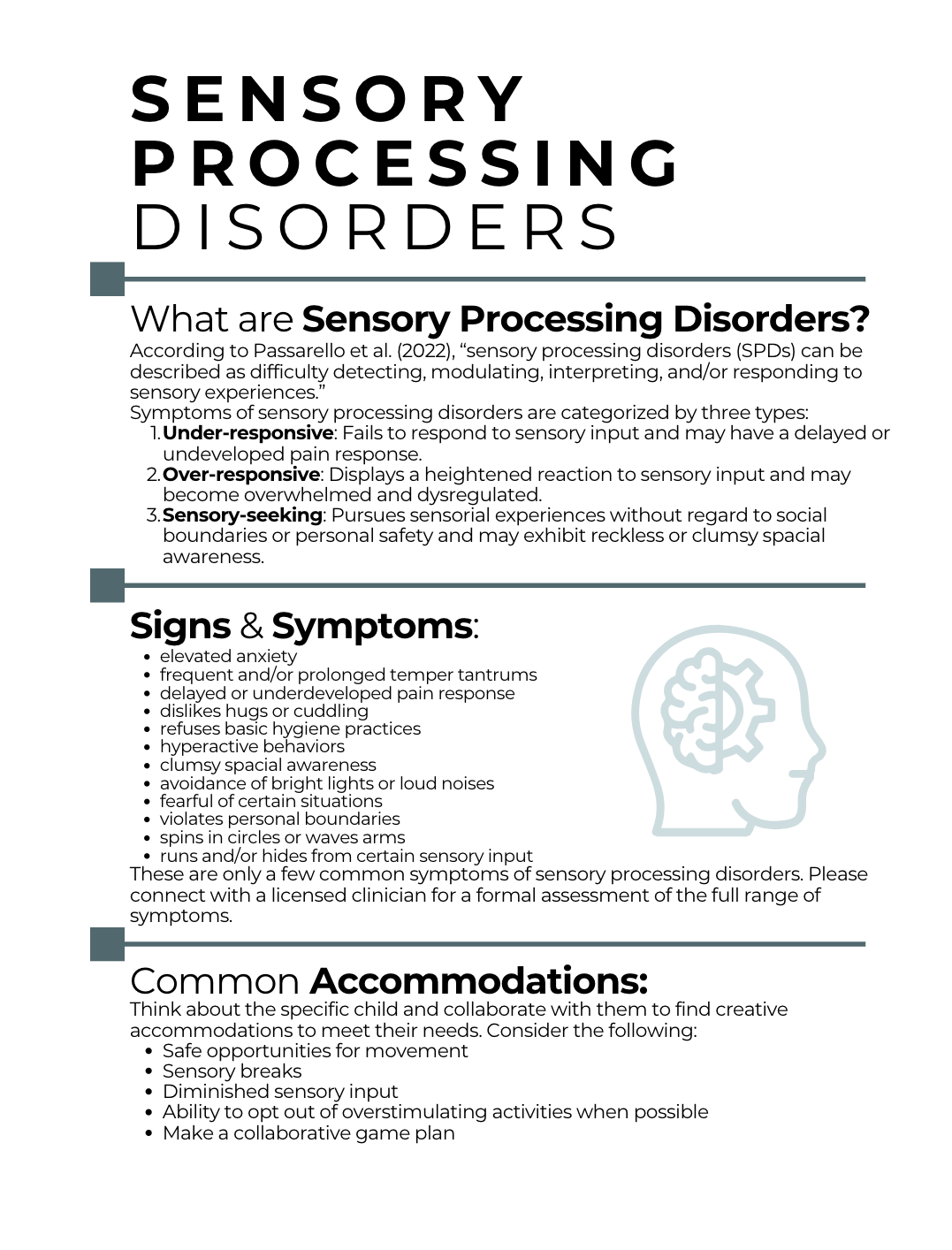Sensory Processing Disorders
and recommended accommodations for home & the Classroom
What are Sensory Processing Disorders?
According to Passarello et al. (2022), “sensory processing disorders (SPDs) can be described as difficulty detecting, modulating, interpreting, and/or responding to sensory experiences.”
Symptoms of sensory processing disorders are categorized by three types:
Under-responsive: Fails to respond to sensory input and may have a delayed or underdeveloped pain response.
Over-responsive: Displays a heightened reaction to sensory input and may become overwhelmed and dysregulated.
Sensory-seeking: Pursues sensorial experiences without regard to social boundaries or personal safety and may exhibit reckless or clumsy spacial awareness.
How do I know if my child has sensory processing needs?
Children with sensory issues may struggle with textures, loud noises, crowds, food preferences, etc. These sensitivities are often seen in children with neurodevelopmental disorders such as autism spectrum disorder (ASD) or attention-deficit/hyperactivity disorder (ADHD), but they can also appear in otherwise typically developing children. Understanding and supporting a child’s unique sensory needs can help them feel more comfortable and engaged in their environment.
Signs and Symptoms:
If you notice that your child struggles more than their peers with sensory input, contact a licensed professional for a formal assessment. If you’re not sure where to start, reach out to your pediatrician for a behavioral health referral, or contact your assigned public school for local (and often free!) resources and accommodations.
elevated anxiety
frequent and/or prolonged temper tantrums
delayed or underdeveloped pain response
dislikes hugs or cuddling
refuses basic hygiene practices
clumsy spacial awareness
avoidance of bright lights or loud noises
fearful of certain situations
violates personal boundaries
spins in circles or waves arms
runs and/or hides from certain sensory input
These are only a few common symptoms of sensory processing disorders. Please connect with a licensed clinician for a formal assessment of the full range of symptoms.
How can we help kids with SPDs thrive?
When a kid has high sensory processing needs, there are simple accommodations we can make to help them feel safe and comfortable. Think about the specific child and collaborate with them to find creative accommodations to meet their needs.
Accommodations can help support kids with sensory processing disorders, but depending on the age and needs of the child, some accommodations may need to be supplemented with professional guidance. If you or your child are struggling with daily functioning, please reach out to a trained professional for personalized treatment.
Common Accommodations for Kids with Sensory Processing Disorders:
Safe opportunities for movement
Kids with SPDs may squirm and fidget more than their peers, so introduce sanctioned ways they can move while also staying on task.
For example, try sensory seats, kick bands, fidget toys, adequate time for free play, etc. Read on for our favorite safe-movement materials!
Sensory breaks
If a task, expectation, or environment is particularly taxing on a child with a SPD, consider allowing them to have planned sensory breaks to maintain emotional regulation.
Thoughtful and/or diminished sensory stimulation
Bright lights, loud noises, strong smells, unfamiliar foods, uncomfortable textiles, large crowds, and overwhelming tasks can contribute to a sensory overload. Observe the environment and consider ways to reduce unnecessary sensorial input when possible.
For example, use lamps with soft light or try a white noise machine to muffle outside noise. Read on for our favorite sensory-friendly gadgets!
When possible, allow kids to opt-out of overstimulating activities
In school, consider letting kids skip loud, crowded assemblies. At home, give kids exit opportunities if they feel overwhelmed at a birthday party or family gathering.
Make a collaborative plan
Kids with SPDs often benefit from feeling prepared and supported. When possible, ask them how they would like to handle difficult situations and how they would like you to help. Check out our “What’s the Plan” resource below for collaborative talking-points!
Sensory Processing Disorders
A printable version of this information is available in our Infographics tab!
What’s the Plan?
Try these talking points to create collaborative game plans for kids with SPDs.
A printable version of this information is available in our Conversation Starters tab!
Recommended Accommodations for Home and School:
A quiet silicone fidget toy to help kids find their calm.
Textured sensory stickers to remind kids to slow down and breathe.
A quiet sensory toy that soothes the mind.
This sensory chair helps kids with balance, coordination, and focus.
A salt lamp gives off a glowy, calming light for when kids need diminished sensory input.
This textured seat cushion allows active kids safe and subtle options for movement.
Sensory rings offer textured stimulation to help kids focus and relax without drawing attention to themselves.
A stability chair helps kids maintain focus and attention while meeting their sensory needs.
A natural sound machine can dampen outside noises to help create a calming environment.
This foot pad is perfect for kids with “busy feet.”
Kick bands allow kids an outlet for quiet movement.
Active free-play helps kids fulfill sensory needs.
REFERENCES
Arky, B. (2023, October 30). Sensory processing issues explained. Child Mind Institute. https://childmind.org/article/sensory-processing-issues-explained/
Passarello, N., Tarantino, V., Chirico, A., Menghini, D., Costanzo, F., Sorrentino, P., Fucà, E., Gigliotta, O., Alivernini, F., Oliveri, M., Lucidi, F., Vicari, S., Mandolesi, L., & Turriziani, P. (2022). Sensory Processing Disorders in Children and Adolescents: Taking stock of assessment and novel therapeutic tools. Brain Sciences, 12(11), 1478. https://doi.org/10.3390/brainsci12111478
Subtypes of SPD. (n.d.). STAR Institute. https://sensoryhealth.org/basic/subtypes-of-spd#sensorycraving
Van Iderstine, S. (2024, March 4). How sensory processing issues affect kids in school. Child Mind Institute. https://childmind.org/article/how-sensory-processing-issues-affect-kids-in-school/
















